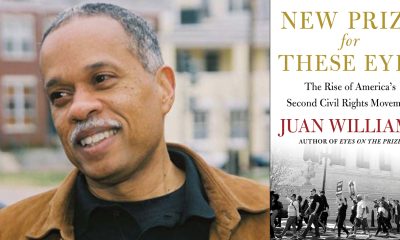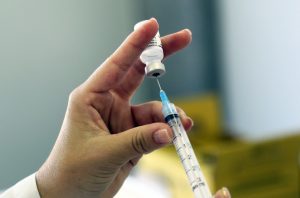Coronavirus
Eastmont Mall Site of Mass COVID-19 Testing Event on Aug. 22-23 Led by Dr. Kim Rhoads
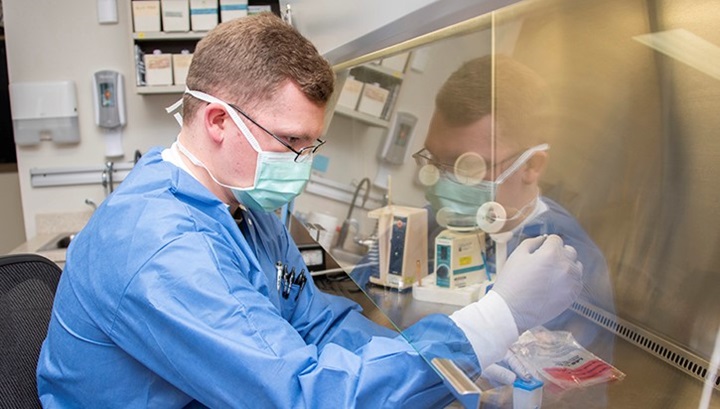
Oakland residents are invited to Eastmont Mall August 22-23, 2020, to attend the largest COVID-19 testing event ever staged in the East Bay.
Umoja Health, a network of doctors in San Francisco, and Oakland Frontline Healers anticipate that more than 1,000 people per day will be tested via drive-thru or walk-up at 7200 Bancroft Ave.
From 10:00 a.m. to 6:00 p.m., testing will be available, and free lunch and free PPE will be distributed to participants. Previous COVID-19 events of this size were successfully staged in May and June in San Francisco’s Sunnydale and Bayview districts, led by Dr. Kim Rhoads.
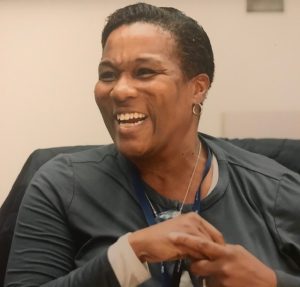
Dr. Kim Rhodes, at a convening with California Surgeon General Dr. Burke Harris
Picture by UCSF staff
Rhoads, who is formally trained and board-certified in general surgery and colon and rectal surgery, is currently an associate professor of epidemiology and biostatistics, focusing on cancer research regarding higher death rates among African Americans, even those cancers they are less prone to develop.
After COVID-19 emerged, Rhoads observed similar disparities in coronavirus infection rates, noting that even though the Latinx population has a higher rate of infection than African Americans, more African Americans are dying.
The situation caused her to reflect on the philosophy of her mentor, Dr. Frank E. Staggers Sr.
Staggers, who transitioned in 2014, was the founding chair of the Community Advisory Board for UCSF’s Helen Diller Family Comprehensive Cancer Center.
Staggers had a strong belief in unlimited human wealth and potential. He promoted strong family values, including the belief that elders must provide a foundation for the next generation to reach its highest promise, and that “family” incorporates the entire community.
Linking the health of an individual with the health of the community was what Staggers practiced, dedicating himself to identifying and developing strategies and solutions to eradicate healthcare disparities.
After practicing surgery on the faculty at Stanford University for nearly a decade, Rhoads decided she wasn’t going to practice anymore, deciding to commit full time to community engagement work.
“When I started medical school I said I wasn’t going to practice medicine. My purpose was to learn all the secrets of the medical system and tell the people what those secrets are,” she said.
With the arc of her life unfolding in this way and the advent of the COVID-19 pandemic, Rhoads reflected on her mentor’s principles, asking herself, “What would Dr. Staggers do?”
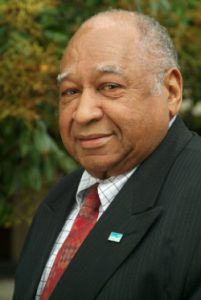
Dr. Frank Staggers Sr.
Picture submitted by Friends of Dr. Frank Staggers Sr.
Rhoads rededicated herself to her life’s mission, leading the effort for the San Francisco COVID-19 testing events and revealing the secret that African Americans are dying at higher rates than any other demographic, and that major intervention is mandatory.
“My department chair at UCSF, Dr. Kirsten Bibbins-Domingo got a call from (Oakland’s) Fruitvale district from Chris Iglesias of the Unity Council and leaders at La Clinica De La Raza who said they had a really big COVID-19 positivity rate and needed our help,” Rhoads said. “We know the rate in East Oakland is high, so we’ve come to where the need is greatest.”
Rhoads is operating under the umbrella of the United in Health initiatives, which are sponsored by UCSF, and the Chan-Zuckerberg Biohub, a collaboration between UCSF, Stanford and UC Berkeley.
The Biohub runs the COVID-19 testing for select community-based testing initiatives. Their tests have a rapid turn-around of getting results within two to three days, a criticism that other massive testing efforts have faced.
“After the August 22nd event, we will continue taking care of people who test positive, providing PPE and resources including food delivery, cleaning supplies and instructions as to how to keep their homes safe, by supporting a Community Wellness Team here in East Oakland.”
“The key is, we’re not going to disappear after this event. We will keep the community wellness teams together and evolve other support as needed.,” Rhoads said. “If people don’t need food, we’ll provide COVID messaging and other COVID activities, but we’re basically trying to keep local groups together to continue serving the community. After COVID we’ll take care of cancer next. It’s what Dr. Staggers would do.”
Rhoads said that health disparities in populations of color stem from health system inequities that have existed for decades and began when white Medicare-based hospitals, supported by the American Medical Association, received more funding than Black Medicaid-based hospitals.
Rhoads explained, “It is undeniable that hospitals, that are Medicaid based, vs. Medicare, take care of more and tougher cases of cancer, often because the disease is so advanced at the time of diagnosis. Academic structures blame the victims for the high rates of death, stating poor health habits, but I have found that the problem stems from disparities in standards of care.”
Rhoads is also an affiliate of Philip R. Lee Institute for Health Policy Studies and associate director of Community Engagement for the Helen Diller Family Comprehensive Cancer Center. She is married to pediatric anesthesiologist Dr. Bill Rhoads, resides in Oakland, and has two teenaged children.
Activism
ESSAY: Technology and Medicine, a Primary Care Point of View
The COVID-19 pandemic, for example, restricted millions of people to their homes, which required reliance on the internet for communication and information. Personal internet searches became essential to understanding information about COVID, human physiology, symptoms, and keeping up with vaccine updates. However, this increase in independent online research resulted in people accessing more misinformation circulating on the internet. This posed a challenge for medical providers trying to treat patients according to research-based guidelines. With so much information within reach, it was difficult for providers to help their patients distinguish between legitimate evidence-based sources and opinion, speculation, and fabrication.

Dr. Adia Scrubb
Special to California Black Media Partners
Technology has enhanced communication between medical professionals and patients; improved patient care management; and eased access to care and information, benefiting both patients and medical clinicians.
However, despite the ease and many conveniences these patient care improvements have ushered in, adequate patient care still includes physician supervision, examinations, and interaction, which present challenges for keeping up with demands on the healthcare system and accurate patient education.
Technology has made more educational resources available at our fingertips, and it has created independence for those who want to know more about their bodies.
The COVID-19 pandemic, for example, restricted millions of people to their homes, which required reliance on the internet for communication and information. Personal internet searches became essential to understanding information about COVID, human physiology, symptoms, and keeping up with vaccine updates. However, this increase in independent online research resulted in people accessing more misinformation circulating on the internet. This posed a challenge for medical providers trying to treat patients according to research-based guidelines. With so much information within reach, it was difficult for providers to help their patients distinguish between legitimate evidence-based sources and opinion, speculation, and fabrication.
Nowadays, patients continuously arm themselves with medical information and challenge clinicians with the research they gather from internet sources to advocate for themselves and their care. This often leaves medical professionals with the complex task of navigating challenging discussions, pointing patients to validated and verified medical information, and following evidence-based medical guidelines for treatment.
Reviewing information before an appointment can certainly make an office visit much more productive, but it is essential to acknowledge the possible bias and limitations of internet searches. Consideration of the author, source, and date of the information may help determine its validity.
Furthermore, simply asking medical professionals for their preferred patient information resources will direct patients to safe and validated information that is in line with standards of care practices. This can help patients better understand the recommendations from their doctors and streamline their internet searches.
Access to individual online medical record information, such as blood tests, MRI reports, and office visit notes, has been a significant expansion of technology in medicine. This digitization of medical information enables and positions patients to take a leading role in managing their care. What used to be multiple sheets of paper in a large file folder is now a click away at any time. Despite these benefits, instant access can be overwhelming for both patients and medical providers, especially since patients, in many instances, can receive their test results online before the physician has had the opportunity to review them.
Patients may review the office visit notes or their lab results out of context or misinterpret information, which can lead to anxiety, confusion, and fear. Clinicians are put in a difficult position when they are not able to suddenly break away from their scheduled office visits to reassure an unscheduled patient about their results and next steps.
Medical providers have tools to assist with identifying sensitive results that need urgent review, and efforts are made to notify anxious patients as soon as possible. However, a patient can be proactive in scheduling a follow-up visit ahead of time to review results with their provider specifically. This can help patients avoid the stress of suddenly trying to get a hold of their doctor when dealing with unclear or concerning results. Normal test results often don’t require explanation, but allowing several days for your provider to work through hundreds of test results before sending messages requesting clarification will help medical professionals prioritize their responses to test results based on medical urgency.
Technological improvements such as online messaging and video/telephone appointments have made access to care much easier both for patients and clinicians. Telephone and video visits have been especially beneficial for patients who are elderly, disabled, or do not have access to transportation. However, the increase — and ease of — access has created much higher demand for physician time both during and outside of the office visit. Test results, patient messages, insurance forms, emails, and medication requests are all pouring in while providers conduct their daily scheduled appointments. Thus, very little time is left in the day for a clinician to respond to every email, fill out every form, and review every lab result when they are responsible for 1,800 or more patients.
This situation, unfortunately, creates a perceived delay in response in a culture where an instant response is expected from messaging and phone calls. But the reality is that the medical provider is constantly playing catch up to thousands of inquiries due to the around-the-clock online access patients now have.
Patients can make the most of their experience and their physician’s time by taking the time to learn their physician’s communication preferences. Despite the multiple modalities of access (telephone, email, video, in-person), a medical provider will have a preferred method of communication with their patients. Some may ask their patients to make an appointment to explain a complex topic, instead of responding to multiple messages. Others may prefer to communicate via phone call if they have to deliver bad news.
There will likely be more medical providers who prefer to communicate only through email or video appointments as remote work becomes more common. If a patient’s communication preferences align with their physician’s preferences, it will create a stronger patient-doctor relationship and foster more effective and impactful communication.
The expansion of technology in medicine has fostered better collaboration, communication, and education between patients and their medical professionals. Combining electronic resources with rapport, mutual respect, and trust for providers will help patients navigate this new landscape of healthcare.
About the Author
Dr. Adia Scrubb, MD, MPP, is a Board-Certified Family Medicine Physician currently practicing in Solano County.
Alameda County
After Years of Working Remotely, Oakland Requires All City Employees to Return to Office by April 7
City Administrator Jestin Johnson recently told city unions that he is ending Oakland’s telecommuting program. The new policy will require employees to come to work at least four days a week. These new regulations go into effect on Feb. 18 for non-union department heads, assistant and deputy directors, managers, and supervisors. All other employees must be back at work by April 7.

By Post Staff
The City Oakland is requiring all employees to return to the office, thereby ending the telecommuting policy established during the pandemic that has left some City Hall departments understaffed.
City Administrator Jestin Johnson recently told city unions that he is ending Oakland’s telecommuting program. The new policy will require employees to come to work at least four days a week.
These new regulations go into effect on Feb. 18 for non-union department heads, assistant and deputy directors, managers, and supervisors. All other employees must be back at work by April 7.
The administration may still grant the right to work remotely on a case-by-case basis.
In his memo to city unions, Johnson said former President Joe Biden had declared an end to the pandemic in September 2022, and that since then, “We have collectively moved into newer, safer health conditions.”
Johnson said “multiple departments” already have all their staff back in the office or workplace.
The City’s COVID-era policy, enacted in September 2021, was designed to reduce the spread of the debilitating and potentially fatal virus.
Many cities and companies across the country are now ending their pandemic-related remote work policies. Locally, mayoral candidate Loren Taylor in a press conference made the policy a central issue in his campaign for mayor.
City Hall reopened for in-person meetings two years ago, and the city’s decision to end remote work occurred before Taylor’s press conference.
At an endorsement meeting last Saturday of the John George Democratic Club, mayoral candidate Barbara Lee said she agreed that city workers should return to the job.
At the same time, she said, the city should allow employees time to readjust their lives, which were disrupted by the pandemic, and should recognize individual needs, taking care to maintain staff morale.
The John George club endorsed Lee for Mayor and Charlene Wang for City Council representative for District 2. The club also voted to take no position on the sales tax measure that will be on the April 15 ballot.
Bay Area
Authorities Warn: There’s a COVID Surge in California
According to data estimates by the Centers for Disease Control and Prevention (CDC), the coronavirus in California’s wastewater has spiked for eight consecutive weeks. Hospitalizations and emergency room visits have also increased since the rise of the new subvariants. Over the last month, Los Angeles County experienced an average of 389 hospital patients per day that tested positive for the coronavirus. The FLiRT subvariants such as KP.3.1.1. Made up over 2% of coronavirus samples nationwide, an increase of more than 7% last month.
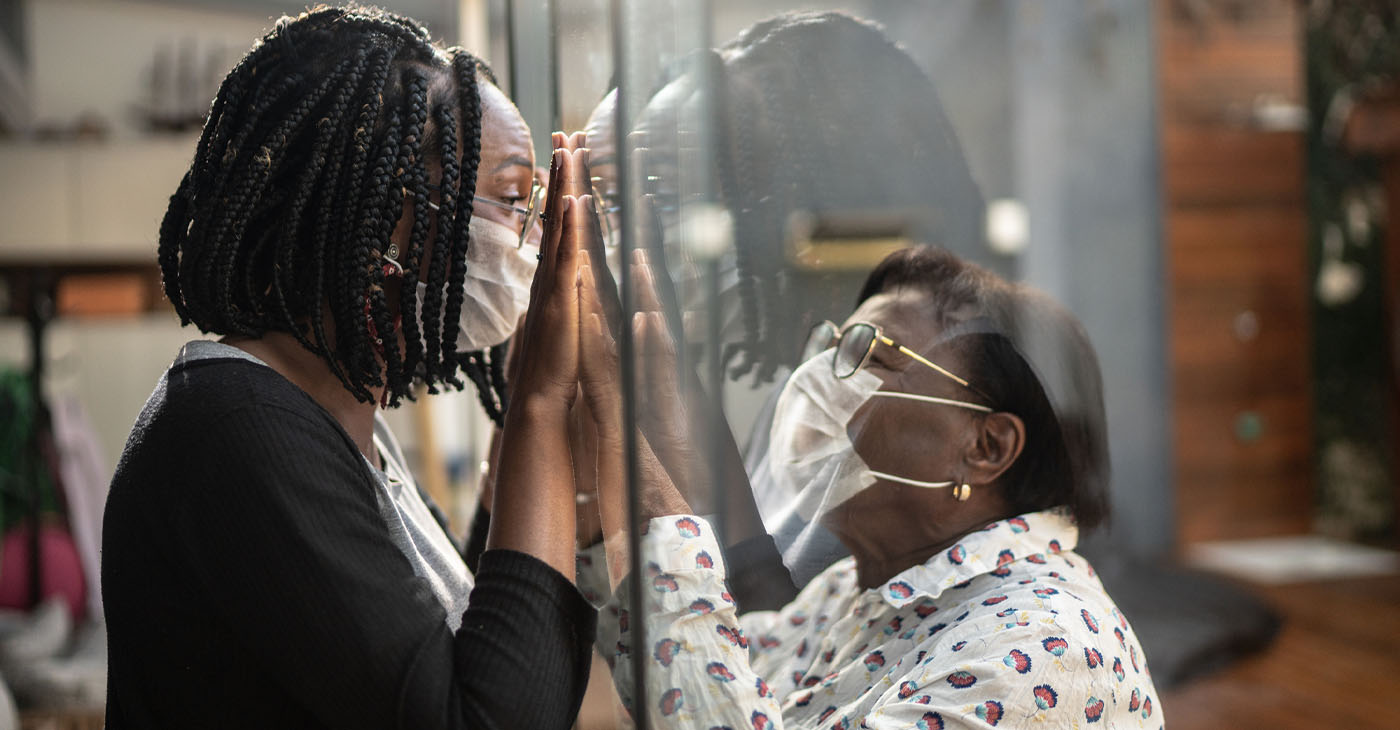
By Bo Tefu, California Black Media
California is experiencing a COVID-19 surge this summer, experts warn, as numbers of infections increased for the third month this year.
State public health authorities attribute the summer COVID surge to more infectious subvariants that have emerged as the coronavirus evolves.
Dr. Elizabeth Hudson, regional chief of infectious disease at Kaiser Permanente Southern California, stated that subvariants of COVID-19 called FLiRT increased in recent months, particularly one named KP.3.1.1 that has become the most common strain in the country.
Dr. Peter Chin-Hong, an infectious diseases expert at UC San Francisco, said that the subvariant KP.3.1.1 seems most adept at transmission.
“The subvariant is the one that people think will continue to take over, not only in the United States, but … around the world,” Chin-Hong said.
According to data estimates by the Centers for Disease Control and Prevention (CDC), the coronavirus in California’s wastewater has spiked for eight consecutive weeks. Hospitalizations and emergency room visits have also increased since the rise of the new subvariants. Over the last month, Los Angeles County experienced an average of 389 hospital patients per day that tested positive for the coronavirus. The FLiRT subvariants such as KP.3.1.1. Made up over 2% of coronavirus samples nationwide, an increase of more than 7% last month.
The majority of the people who tested positive for COVID-19 complained of a sore throat and a heavy cough. Risk factors that can increase the illness include age, underlying health issues, and vaccine dosage.
Health experts stated that the demand for the COVID-19 vaccine has increased in Northern California. However, people are having a hard time getting the vaccine due to the increasing number of cases.
-

 Activism4 weeks ago
Activism4 weeks agoOakland Post Endorses Barbara Lee
-

 Activism3 weeks ago
Activism3 weeks agoOakland Post: Week of April 2 – 8, 2025
-

 #NNPA BlackPress3 weeks ago
#NNPA BlackPress3 weeks agoTrump Profits, Black America Pays the Price
-

 Activism2 weeks ago
Activism2 weeks agoOakland Post: Week of April 9 – 15, 2025
-

 #NNPA BlackPress3 weeks ago
#NNPA BlackPress3 weeks agoHarriet Tubman Scrubbed; DEI Dismantled
-

 #NNPA BlackPress3 weeks ago
#NNPA BlackPress3 weeks agoTrump Targets a Slavery Removal from the National Museum of African-American History and Culture
-

 #NNPA BlackPress3 weeks ago
#NNPA BlackPress3 weeks agoLawmakers Greenlight Reparations Study for Descendants of Enslaved Marylanders
-

 #NNPA BlackPress3 weeks ago
#NNPA BlackPress3 weeks agoNew York Stands Firm Against Trump Administration’s Order to Abandon Diversity in Schools











